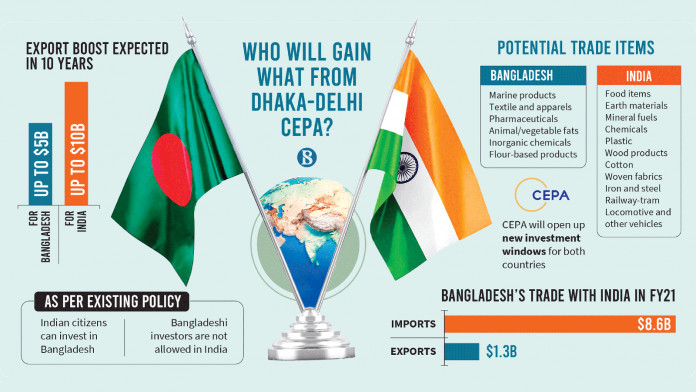Exploring Global Alternatives to Indian Commodity Imports for Bangladesh
Md. Joynal Abdin, BBA (Hons.), MBA
Founder & CEO, Trade & Investment Bangladesh
Secretary General, Brazil Bangladesh Chamber of Commerce & Industry (BBCCI)
Bangladesh has long been a significant player in South Asia, showcasing remarkable economic growth over the past few decades. A crucial component of this growth has been its trade relationships, particularly with India, which stands as one of the country’s primary trading partners. Currently, a substantial portion of Bangladesh’s commodity imports comes from India, covering essential goods such as textiles, agricultural products, and various raw materials. This reliance on a single trading partner has created a complex web of economic interdependencies that, while beneficial in the short term, poses substantial risks to the country’s long-term stability and growth.
The heavy dependence on Indian imports has made Bangladesh vulnerable to external shocks. Any fluctuations in India’s economy, changes in trade policies, or geopolitical tensions can directly impact the availability and pricing of essential commodities in Bangladesh. For instance, disruptions caused by political disagreements or trade disputes could lead to supply shortages, inflation, or increased costs for consumers and businesses alike. Therefore, the current import structure raises concerns regarding the resilience of Bangladesh’s economy in the face of such uncertainties.
Diversifying commodity import sources is not merely an economic strategy but a necessity for ensuring stability and sustainability. By exploring alternative markets, Bangladesh can mitigate risks associated with over-reliance on a single country. This diversification can enhance competition, leading to better prices and improved quality for imported goods. Moreover, it can bolster Bangladesh’s bargaining power in international trade negotiations and foster stronger economic ties with a broader range of nations.
In light of the challenges and risks posed by the current reliance on Indian imports, it is imperative for Bangladesh to reassess its trading strategies. This shift toward diversification not only promises economic benefits but also aligns with broader global trends, where countries increasingly seek to build resilient supply chains and reduce vulnerability to external shocks. By strategically identifying and engaging with alternative markets, Bangladesh can position itself for sustained economic growth and development in an increasingly interconnected world.
Ultimately, the journey toward diversifying commodity imports requires a concerted effort from all stakeholders, including the government, private sector, and trade organizations. By embracing this challenge, Bangladesh can ensure a more robust and resilient economy capable of navigating the complexities of global trade.
2. Current State of Commodity Imports
India is one of Bangladesh’s largest trading partners, playing a crucial role in the country’s import landscape. The bilateral trade between the two nations has seen significant growth over the years, with India supplying various essential commodities that meet the demands of the Bangladeshi market.
Major Commodities Imported from India are as follows:
- Machinery and Equipment: This category includes agricultural machinery, generators, and various industrial machinery.
- Cotton: India is a major supplier of raw cotton to Bangladesh’s textile industry, which is vital for the country’s garment manufacturing sector.
- Chemicals: Includes pharmaceuticals, fertilizers, and other chemical products, which are essential for agriculture and industrial processes.
- Electrical and Electronics: This encompasses items like electrical machinery, telecommunication equipment, and consumer electronics.
- Food Products: Bangladesh imports various food products, including sugar, tea, and spices, from India to meet local demand.
According to the Bangladesh Bureau of Statistics (BBS) and the Ministry of Commerce, In the fiscal year 2022-2023, Bangladesh imported approximately $1.6 billion worth of textiles and apparel machinery from India, while cotton imports amounted to around $1.3 billion. Overall, India accounted for roughly 25% of Bangladesh’s total imports, making it a significant trading partner. In total, the value of imports from India reached approximately $10 billion in the fiscal year 2022-2023, reflecting a steady increase from previous years. This growth can be attributed to increasing demand for machinery and raw materials for Bangladesh’s textile and agricultural sectors.
3. Bangladesh’s Risk of Dependency on India for Commodity Import:
The trade relationship between Bangladesh and India is marked by significant economic interdependence. While this relationship has many advantages, it also brings with it a series of risks that can affect Bangladesh’s sovereignty, economic stability, and long-term growth. The reliance on India for essential commodities poses unique challenges that need to be examined in detail.
3.1 Indian Illegal Interference in Bangladesh Politics: The geopolitical dynamics in South Asia often influence domestic politics in Bangladesh. Allegations of Indian interference in Bangladesh’s political affairs, especially during elections or political crises, raise concerns about sovereignty. Associated risks are
- Erosion of Sovereignty: Constant interference can lead to a perception of compromised sovereignty, undermining public trust in the government.
- Political Instability: When political parties or factions are perceived as being aligned with or supported by India, it can create internal conflicts and instability.
- Public Discontent: Interference may lead to public backlash against the government and India, resulting in political unrest and potential disruptions in trade.
3.2 Imposition of Export Ban from Political Motives: India has, at times, imposed export bans on critical commodities such as rice and onions, citing domestic supply concerns or political motivations. These actions can have serious implications for Bangladesh, which relies on India for a substantial portion of its food imports. Associated risks are
- Supply Chain Disruptions: Export bans can lead to immediate shortages in Bangladesh, affecting food security and price stability.
- Increased Prices: When India restricts exports, Bangladesh may be forced to source these commodities from more expensive markets, increasing inflation and the cost of living.
- Economic Vulnerability: The dependency on Indian exports makes Bangladesh vulnerable to Indian domestic policies and political decisions, limiting its ability to control its own food security.
3.3 Imposition of Export Duty to Increase Production Costs in Bangladesh: The imposition of export duties on essential commodities by India can directly affect the cost structure of Bangladesh’s industries that rely on these imports. Associated risks are
- Increased Production Costs: Export duties can lead to higher costs for raw materials, impacting the competitiveness of Bangladeshi goods in both local and international markets.
- Reduced Profit Margins: Industries relying on Indian imports may see reduced profit margins, hampering investment and growth prospects.
- Potential for Supply Chain Disruptions: If Indian producers prioritize domestic sales due to increased export costs, the availability of these commodities in Bangladesh may decrease.
3.4 Limited Trade Diversification: A heavy reliance on India limits Bangladesh’s trade diversification, making it vulnerable to shifts in India’s economic and political landscape. Associated risks are
- Loss of Bargaining Power: A lack of alternative suppliers reduces Bangladesh’s negotiating power with India, potentially leading to unfavorable trade terms.
- Economic Shock Vulnerability: An over-reliance on one trading partner exposes Bangladesh to greater risks in case of economic downturns or trade disputes.
- Dependency Cycle: Limited diversification may reinforce a dependency cycle, where Bangladesh continues to rely heavily on India, further entrenching the risks associated with that reliance.
3.5 Geopolitical Tensions and Border Issues: Bangladesh shares a long border with India, which is often a source of tension due to issues like smuggling, illegal migration, and border disputes. Associated risks are
- Increased Border Security: Tensions can lead to increased security measures along the border, impacting trade flow and logistics.
- Potential for Conflict: Disputes over border issues can escalate, potentially leading to confrontations that could disrupt trade.
- Economic Disruption: Ongoing tensions may deter investment and disrupt business operations, impacting overall economic growth.
3.6 Environmental and Social Impacts: Trade dependency on India can have environmental implications, especially in industries like textiles and agriculture. Associated risks are
- Resource Depletion: Increased demand for raw materials may lead to unsustainable exploitation of resources, affecting local ecosystems and livelihoods.
- Labor Exploitation: There is a risk of social and labor exploitation if dependency leads to a race to the bottom regarding labor standards in a bid to keep production costs low.
- Climate Vulnerability: Bangladesh is one of the most climate-vulnerable countries in the world; dependence on a single source for commodities can exacerbate the impacts of climate change on agricultural and industrial production.

4. Identifying Alternative Markets
As Bangladesh seeks to diversify its sources for essential commodities and reduce dependency on India, several countries present viable alternatives for sourcing various products. Here’s an analysis of potential countries for sourcing commodities and specific products that can be imported.
4.1. Brazil:
Key Commodities
- Soybeans: Brazil is one of the largest producers of soybeans, and Bangladesh can import this vital crop for its animal feed and food processing industries.
- Sugar: Brazil is also a leading exporter of sugar. Bangladesh can benefit from sourcing sugar at competitive prices.
- Meat Products: Brazil has a well-established meat industry, particularly in beef and poultry, which can cater to Bangladesh’s increasing demand for protein sources.
Advantages
- Quality and Quantity: Brazil’s agricultural sector is robust, providing high-quality products in large quantities.
- Diverse Offerings: Beyond agriculture, Brazil offers a range of commodities, including minerals and industrial goods.
4. 2. China
Key Commodities
- Machinery and Equipment: China is a major global supplier of machinery, including textiles, electronics, and industrial equipment, essential for Bangladesh’s manufacturing sector.
- Chemicals: Importing chemical products, including fertilizers and pharmaceuticals, can help support Bangladesh’s agricultural and healthcare sectors.
- Textiles: China can provide raw materials and finished textile products to bolster Bangladesh’s garment industry.
Advantages
- Established Trade Routes: China has well-developed trade networks with Bangladesh, facilitating smoother logistics and lower transportation costs.
- Competitive Pricing: Due to economies of scale, China can often provide products at competitive prices.
4.3. Thailand
Key Commodities
- Rice: Thailand is one of the largest exporters of rice. Bangladesh can source high-quality rice varieties to bolster its food security.
- Fruits and Vegetables: Thailand has a diverse range of agricultural products, including tropical fruits and vegetables, which can enhance Bangladesh’s food imports.
- Rubber: Thailand is a leading exporter of natural rubber, which is essential for Bangladesh’s manufacturing sector, particularly for tires and other products.
Advantages
- Established Trade Relations: Bangladesh and Thailand have a history of trade, making it easier to establish and expand import agreements.
- Quality Products: Thai agricultural products are known for their quality, which can enhance the variety available in the Bangladeshi market.
4.4. Indonesia
Key Commodities
- Palm Oil: Indonesia is the world’s largest producer of palm oil. Bangladesh can import palm oil for cooking and industrial use.
- Coconut Products: Indonesia offers a range of coconut products, including copra, coconut oil, and desiccated coconut, which can diversify the market.
- Minerals: Indonesia is rich in mineral resources, including nickel and tin, which are essential for various industries.
Advantages
- Diverse Agricultural Products: Indonesia has a wide array of agricultural exports that can meet different consumer needs in Bangladesh.
- Strategic Location: The geographical position of Indonesia allows for potential logistical benefits in sourcing products from Southeast Asia.

5. Challenges and Barriers to Diversification
While diversifying commodity imports is crucial for reducing dependency on a single trading partner like India, Bangladesh faces several challenges and barriers in this endeavor. Understanding these obstacles is essential for developing strategies to overcome them.
5.1. Infrastructure Limitations: Bangladesh’s infrastructure, including transportation, logistics, and port facilities, can hinder efficient import processes.
- Inadequate Transport Networks: Poor road and rail connectivity can lead to delays in importing goods from alternative sources, increasing costs and reducing competitiveness.
- Port Congestion: Overcrowded ports can cause significant bottlenecks, affecting the timely arrival of commodities.
- Logistical Challenges: Lack of modern logistics and warehousing facilities can complicate the distribution of imported goods within Bangladesh.
5.2. Political and Regulatory Issues: Political stability and regulatory frameworks play a critical role in trade relationships.
- Bureaucratic Hurdles: Lengthy customs procedures and bureaucratic inefficiencies can deter potential trading partners from engaging with Bangladesh.
- Regulatory Uncertainty: Frequent changes in trade policies and regulations can create an unpredictable business environment, discouraging foreign suppliers.
- Corruption: Corruption within customs and trade agencies can lead to increased costs and delays, making it difficult for new suppliers to enter the market.
5.3. Economic Factors: Economic considerations can impact Bangladesh’s ability to diversify its imports.
- Foreign Exchange Reserves: Limited foreign exchange reserves can restrict Bangladesh’s ability to engage in trade with multiple countries, particularly for essential commodities.
- Price Volatility: Global commodity price fluctuations can make it challenging for Bangladesh to secure stable and affordable imports from alternative sources.
- Competition with Domestic Producers: Domestic industries may resist imports from new sources due to fears of increased competition, which could affect local employment and production.
5.4. Lack of Market Knowledge: Understanding the dynamics of new markets is crucial for successful diversification.
- Limited Information: Lack of comprehensive market intelligence on potential suppliers can hinder effective decision-making.
- Cultural and Business Practices: Different cultural and business practices in alternative sourcing countries may pose challenges in negotiations and trade relationships.
5.5. Supply Chain Complexity: Complexities within global supply chains can hinder diversification efforts.
- Integration with Existing Supply Chains: Integrating new suppliers into established supply chains can be difficult and may require significant adjustments.
- Logistical Coordination: Coordinating logistics across different countries can complicate the import process, leading to increased costs and delays.
6. Government Initiatives and Policy Recommendations
To reduce dependency on India for commodity imports and enhance the resilience of the Bangladeshi economy, the government can undertake various initiatives and implement policy recommendations. These measures can help foster alternative sourcing, improve trade relationships, and facilitate the diversification of imports.
6.1. Strengthening Trade Agreements
- Bilateral and Multilateral Agreements: Bangladesh should actively pursue trade agreements with potential alternative sourcing countries like Brazil, Vietnam, Thailand, Indonesia, and China. Such agreements can facilitate tariff reductions and improve trade relations, making it easier to import commodities.
- Trade Missions: Organizing trade missions and business delegations to explore opportunities in potential sourcing countries can help build relationships and promote Bangladeshi exports while attracting imports.
6.2. Enhancing Infrastructure Development
- Investment in Transportation: The government should invest in improving transportation networks, including roads, railways, and ports, to facilitate efficient logistics and reduce costs associated with importing commodities from diverse sources.
- Logistics Hubs: Establishing logistics hubs with modern facilities can streamline the import process and enhance the country’s capability to handle increased trade volumes.
6.3. Simplifying Regulatory Frameworks
- Streamlining Customs Procedures: The government should work to simplify and modernize customs procedures to reduce bureaucratic hurdles, enhance transparency, and decrease the time and costs involved in importing commodities.
- Trade Facilitation Measures: Implementing measures like single-window clearance systems can expedite the import process, making it more attractive for alternative suppliers.
6.4. Providing Financial Support and Incentives
- Subsidies and Tax Incentives: Offering subsidies or tax incentives to importers who source from alternative countries can encourage diversification of imports and reduce dependency on a single source.
- Export Credit Agencies: Establishing or enhancing export credit agencies can provide financing options for businesses looking to explore new markets for imports, mitigating risks associated with trade.
6.5. Promoting Market Intelligence and Research
- Market Research Programs: The government can fund market research initiatives to provide businesses with critical information about potential alternative suppliers, pricing trends, and market dynamics.
- Trade Information Portals: Creating online platforms that aggregate information about sourcing options, supplier reliability, and market conditions can aid businesses in making informed decisions.

7. Policy Recommendations
7.1. Diversification Strategy Framework
- National Import Diversification Strategy: The government should develop a comprehensive strategy that outlines clear goals, timelines, and action plans for diversifying imports. This strategy should include specific targets for sourcing from various countries.
7.2. Capacity Building and Training
- Skills Development Programs: Implementing training programs for businesses to enhance their capacity to engage in international trade can improve competitiveness and encourage alternative sourcing.
- Workshops and Seminars: Organizing workshops to educate businesses about international sourcing practices, quality assurance, and compliance can facilitate smoother imports from diverse markets.
7. 3. Strengthening Trade Relations with Emerging Markets
- Fostering Diplomatic Ties: Strengthening diplomatic relations with emerging markets can enhance trade opportunities and create an environment conducive to alternative sourcing.
- Joint Ventures and Collaborations: Encouraging joint ventures between Bangladeshi and foreign companies can facilitate technology transfer, knowledge sharing, and access to new markets.
7.4. Supporting Local Industries
- Encouraging Local Production: Implementing policies that promote local production of essential commodities can reduce reliance on imports and create a buffer against external shocks.
- Research and Development: Investing in R&D initiatives can help identify alternative crops and products that can be sourced domestically, further reducing dependency on imports.
7.5. Monitoring and Evaluation
- Regular Assessment: The government should establish a framework for regular monitoring and evaluation of import diversification initiatives to assess their effectiveness and make necessary adjustments.
- Feedback Mechanisms: Creating channels for businesses to provide feedback on trade policies and sourcing challenges can help the government fine-tune its approach to facilitating alternative sourcing.
8. Conclusion
In conclusion, diversifying commodity imports is a strategic necessity for Bangladesh to enhance its economic resilience and reduce reliance on a single trading partner like India. By exploring alternative sourcing options from countries such as Brazil, China, Vietnam, Thailand, and Indonesia, Bangladesh can tap into a wider array of commodities and strengthen its trade relationships. This approach not only secures essential supplies but also mitigates risks associated with geopolitical tensions and market fluctuations.
To successfully implement these diversification efforts, the government must prioritize infrastructure development, simplify regulatory frameworks, and foster international trade agreements. By investing in transportation, streamlining customs processes, and promoting market intelligence, Bangladesh can create an enabling environment for businesses to engage with new suppliers effectively. Furthermore, providing financial incentives and support for capacity-building initiatives will empower local industries to adapt and thrive in the competitive global marketplace.
Ultimately, a comprehensive strategy focusing on import diversification will position Bangladesh for sustainable economic growth. As the country navigates the complexities of international trade, embracing a proactive approach will not only enhance food security and economic stability but also foster a more competitive and resilient economy that can withstand future challenges.


